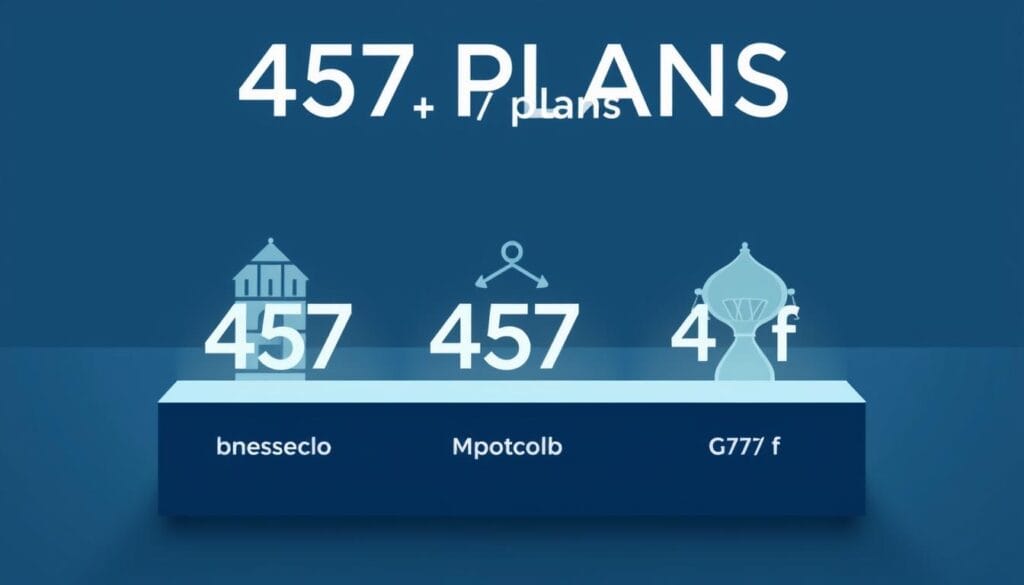Surprising fact: about 30% of mid-size companies use select deferred-pay programs to boost executive pay and retain top talent.
This guide explains how those arrangements work. A non-qualified retirement plan is an employer-sponsored program that sits outside standard qualified plan rules. It lets a company offer targeted compensation deferrals or extra benefits to select employees beyond 401(k) caps.
These plans can be set up as deferred pay, SERPs, phantom stock, or insurance strategies. They defer tax until distribution, which can add value through compounding and lower future tax rates. Companies use these tools to stay competitive when standard plans fall short.
Employees usually make deferral elections ahead of the plan year, and firms keep participation limited to key staff to preserve flexibility. If you want to start planning, the next sections compare these programs to qualified options and walk through mechanics, types, benefits, and risks.
Key Takeaways
- These employer arrangements let select staff defer compensation beyond standard 401(k) limits.
- Taxes are generally deferred until benefits are paid, offering potential long-term value.
- Common types include SERPs, phantom stock, and insurance-based strategies.
- Companies limit participation to key employees to keep rules flexible for the business.
- Deferral elections occur before the plan year and carry employer credit risk and limited early access.
Non-qualified retirement plans at a glance: definition, purpose, and how they differ from qualified plans

Some firms create bespoke deferred-pay agreements to reward executives and fill gaps left by usual savings vehicles.
What they are: A non-qualified retirement plan is an employer promise to pay extra compensation later. These arrangements let select staff defer more than typical limits and receive tailored payouts tied to performance or tenure.
Qualified vs. non-qualified: tax treatment, contribution limits, and ERISA coverage
Qualified plans like 401(k)s follow IRS-set contribution limits and ERISA protections. Contributions enjoy defined tax deferral rules until distribution.
By contrast, non-qualified options avoid many Title I rules by limiting eligibility. Benefits are usually taxable when paid or made available, and they remain unsecured obligations of the employer.
| Feature | Qualified | Non-qualified |
|---|---|---|
| Coverage | Broad employee groups | Select group, often highly compensated employees |
| Contribution limits | IRS-set limits | No statutory limits; customized amounts |
| ERISA Title I | Subject to rules | Often exempt when limited to key staff |
Who typically uses these arrangements
Key executives and other highly compensated individuals use them to boost savings and defer tax into later years. Employers and the plan sponsor gain design flexibility, but participants accept employer credit risk.
For more on coordinating benefits with public programs, see how to maximize your Social Security.
How a non-qualified retirement plan works: deferrals, taxation, and distributions

A clear election up front sets the mechanics in motion. A participant chooses to defer a portion of pay before the year begins. That election reduces current taxable income and shifts recognition into a later taxable year.
Deferral mechanics and investment crediting
Deferred compensation is tracked as a notional account. Earnings are credited using deemed investment options so amounts grow without current tax.
When amounts become taxable
Paid or made available is the key test: an amount is taxed when a participant can receive it, even if cash isn’t yet handed over. That timing controls which year shows the income for income tax purposes.
Distribution events and timing
Allowable distribution triggers include severance from employment, unforeseeable emergencies (with strict documentation), specified distribution dates, and termination of the arrangement.
| Item | Typical rule | Effect |
|---|---|---|
| Election timing | Before the plan year | Locks deferral and distribution dates |
| Taxation test | Paid or made available | Determines taxable year |
| Changes to schedule | Limited by rules | May accelerate tax if mishandled |
| Loans | Generally prohibited in non-governmental 457(b) | Attempted loans can cause failures and immediate tax |
Administrative rules matter: timely elections and careful coordination across years help manage tax brackets and avoid income bunching. Participants should review program rules and seek advice before making elections.
Types of non-qualified retirement plans

Companies use several selective designs to reward key staff and tie future payouts to service or performance.
Elective deferred compensation
Elective deferred compensation plans let eligible employees elect to move salary or bonus money to a later date.
This creates a tailored stream of future income and can smooth tax timing for the participant.
Supplemental Executive Retirement (SERP)
SERPs are employer-funded promises that top up standard benefits.
They often vest by service or performance and give a predictable benefit tied to tenure.
Phantom stock and performance cash
Phantom stock tracks company value without issuing equity.
Performance cash pays based on targets, aligning incentives while preserving ownership.
Executive bonus and split-dollar insurance
Executive bonus strategies use permanent life insurance to build tax-deferred cash value the executive can access per policy rules.
Split-dollar arrangements split policy costs, cash value, and death benefits between the company and the executive under agreed terms.
Disability wage continuation and selective designs
Disability wage continuation replaces income for critical roles during illness or injury.
Other selective designs include tailored contributions, forfeiture rules, and performance-linked payouts.
- Value drivers: timing of contributions, vesting, performance linkage, and payout form.
- Admin needs: clear documentation, careful funding decisions, and robust recordkeeping to protect tax treatment and benefit security.
- For a look at growth-oriented investments that can complement deferred strategies, see top ETFs for long-term growth.
Understanding 457 plans: governmental 457(b), non-governmental 457(b), and 457(f)

IRC §457 addresses deferred compensation that state and certain tax‑exempt employers may offer. These arrangements differ in funding, eligibility, and when amounts become taxable.
Eligible 457(b) basics and comparison
Who sponsors these plans: state and local government units and qualifying 501(c) organizations.
Governmental 457(b) options operate similarly to other qualified vehicles in how participants defer income and claim tax deferral until distribution.
Non-governmental 457(b): unfunded status and rabbi trusts
Unfunded requirement: assets remain the employer’s property and are exposed to general creditors.
Many companies place funds in a rabbi trust for recordkeeping and comfort, but that trust does not remove creditor risk.
Non‑governmental arrangements must limit membership to a select group of management or highly compensated employees to avoid ERISA Title I funding rules.
457(f) and substantial risk of forfeiture
457(f) covers ineligible deferrals that rely on a substantial risk of forfeiture. When that risk lapses, the deferred amount is taxable in the taxable year it vests.
Catch-up contributions and distribution events
Governmental 457(b) allows an age‑50 catch-up. Both governmental and non‑governmental 457(b) can use the three‑year pre‑retirement catch‑up for unused prior deferrals.
Permitted distributions include severance, unforeseeable emergency, plan termination, small amounts, and age 70½ events. Loans treated as distributions can trigger failures.
“Excess deferrals (plus earnings) must be corrected by April 15 following the taxable year to avoid disqualification.”
Common compliance pitfalls
- Missed corrections for excess contributions.
- Poor documentation for unforeseeable emergencies.
- Failing to file required Top Hat notices for non‑governmental arrangements.
| Feature | Governmental 457(b) | Non‑governmental 457(b) |
|---|---|---|
| Funding | Can be informally funded; assets generally protected | Must remain unfunded; assets subject to employer creditors |
| Eligibility | Broader employee groups allowed | Select group of management/highly compensated employees |
| Catch‑up | Age‑50 catch‑up and 3‑year catch‑up | 3‑year catch‑up only; no age‑50 catch‑up |
| Reporting | Standard reporting rules apply | No Form 5500; Top Hat notice to DOL required |
For IRS guidance on non‑governmental 457(b) compliance, see the IRS resource. To explore how these choices fit a broader savings strategy, start planning with related savings options.
Benefits and trade-offs: tax advantages, contribution flexibility, and credit risk
Selective deferred arrangements can let eligible employees save more than they could through standard workplace accounts. These designs often allow sizable pre-tax deferrals, increasing the potential for long-term compounding value compared with investing after-tax in a taxable account.
Potential for higher savings beyond 401(k) limits
Plans allow contributors to move large portions of pay into future years, so contributions are not bound by IRS 401(k) caps. That boost can grow faster because earnings compound before tax.
Lower tax in retirement and multi-year distributions
Spreading payouts over several years often yields a lower tax bill than a single lump sum. Reduced earned income in later years, state tax moves, or future rate changes can produce lower tax outcomes for beneficiaries.
Risks: employer credit exposure, lack of rollover, and limited access to money
These benefits come with clear trade-offs. Balances are unsecured promises to the company, so credit problems at the employer can put income at risk.
Most arrangements cannot be rolled into IRAs or other workplace accounts, and money is typically locked until allowed distribution events. That limited liquidity means careful cash-flow planning is essential.
| Feature | Benefit | Trade-off |
|---|---|---|
| Higher contributions | Greater accumulation potential | No IRS cap; subject to plan rules |
| Tax deferral | Compounding before tax grows value | Tax due when paid; timing matters |
| Distribution form | Installments manage tax brackets | Elections often fixed; limited flexibility |
| Credit exposure | Potential company support | Unsecured if employer is insolvent |
| Rollover options | None in most cases | No IRA transfer; must plan payouts |
Practical tip: regularly review deferral elections, contributions, and distribution schedules as years pass. Periodic updates help align payout timing with income needs, tax forecasts, and job changes.
Eligibility, plan design, and operations: what employers and participants should know
Limiting access to a defined executive group keeps selective arrangements outside broad ERISA rules. Employers must define the “select group” so only key management and highly compensated employees participate. That limit preserves intended treatment and reduces Title I exposure.
Plan sponsors should keep arrangements unfunded when required, file Top Hat notices with the DOL, and keep crisp documentation for eligibility, deferral election timing, distribution triggers, and unforeseeable emergency rules.
Operational controls and sponsor duties
Accurate payroll processing, timely deferral elections, and strict emergency administration prevent failures. Sponsors must correct excess contributions promptly and report amounts on W‑2s when applicable.
Participant choices and coordination
Participants pick deferral levels, investment crediting options, and pre-elect distribution schedules to manage tax brackets. Employers often coordinate these arrangements with qualified benefits, equity awards, and SERPs to balance total compensation.
“Regular reviews each period help align deferral and distribution strategies with changing income and company goals.”
For practical guidance, see retirement tips for remote workers.
Conclusion
Smart distribution modeling can turn deferred pay into a smoother, lower-tax income stream in later years.
Recap: these selective arrangements expand savings for key employees while offering tax deferral and investment growth potential. The core trade-off is clear: greater value versus unsecured employer exposure and limited access to money during the deferral period.
Deferral elections, distribution timing, and payout amounts shape annual income and income tax in each year. Model multi-year distributions to spread tax, and consider state moves to lower overall tax bills.
Employers and participants should align compensation features with business goals, keep robust documentation, and maintain tight operations. For a practical comparison of qualified and alternative options, see qualified vs. non‑qualified overview, and for tools to model outcomes try AI planning resources.
Action: revisit deferrals, contributions, and distributions annually to optimize value and manage tax and credit risk.

